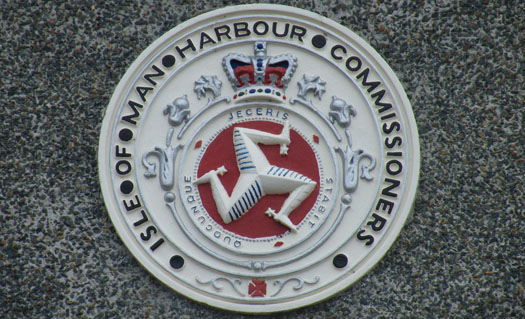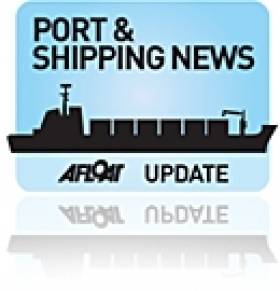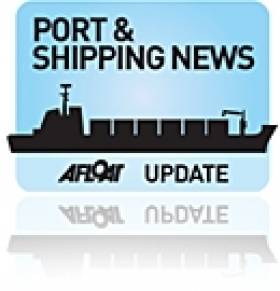Displaying items by tag: Manx Shipping
Classic 60’s ‘Coaster’ Cargoship Returns to Manx Liner Services
#ManxShipping – Ramsey based Mezeron Freight Services coaster-general cargoship, Silver River (1968/277grt) returned to her Irish Sea 'liner' services in late August, following an extensive survey in a Polish shipyard, writes Jehan Ashmore.
As previously reported during a visit to the Isle of Man earlier this year, the single-ship operators of Silver River were able to confirm to Afloat.ie that she was undergoing a marine class survey work at the Morska Yard in Swinoujscie. On completion of the survey, her repositioning voyage from Poland last month involved an en route call to Falmouth for bunkers before arriving in home waters.
Silver River operates for the only Manx 'cargo' based shipping company which provides two liner routes. One of these is the Belfast-Ramsey service. At time of writing, Silver River is heading outward of Belfast Lough on a routine (Wednesdays) sailing as scheduled from Northern Ireland to the Isle of Man.
Tomorrow she discharges her cargo at the north-east Isle of Man port before loading again for the second liner service, that been Ramsey-Glasson Dock in Lancashire.
Among the cargo carried on board the Ramsey registered classic 1960's veteran 'coaster' is bagged cement, fertiliser and 20-ft (TEU) containers.
It is understood Silver River at almost 45m long is the last of the small old coaster-general cargoships operating a regular service within the boundaries of the Irish Sea. Her re-entry to service now nearing her 50th year is a testament to her German shipbuilders, Schiffswerft Schloemer in Moormerland. She was launched in 1968 as the Seacon.
The return of this rare breed of classic coaster will also be welcomed by followers of such ship port trade activity within Irish and UK waters.
In recognition of her Irish Sea coastal trading, the Isle of Man Post Office last year issued a special Manx Maritime Heritage Series Cover to celebrate the cargo company that has kept the island supplied for three decades since formation in 1983.
During her absence over several months, the larger 67m Isis (1978/674grt) was chartered from Great Glen Shipping based in Fort William, Scotland. Likewise of Silver River, she has a Manx registry of Douglas and is flagged under the UK's Red Ensign.
Following Silver River's return, the former Channel Islands serving Isis that once traded as David Doorman for Alderney Shipping, departed Ramsey for Pennyghael on the Isle of Mull.
Manx Shipping Scene: Not Just the Preserve of Douglas
#ManxShippingScene – Outsiders could easily conclude that the Manx capital, Douglas is exclusively where all shipping activity takes place given the traditional 'steam-packet' links between the island and the UK and Ireland, not so, head northwards to Ramsey, writes Jehan Ashmore.
Before, we do just a little background to The Isle of Man Steam Packet Co which they claim to be the oldest continually operating passenger shipping company in the world, having begun operations in 1830.
The company, also known simply as the 'steam-packet', remains very much at the heart of Manx shipping scene and playing a pivotal role as the economic, cultural and social life-line in operating the main routes to England and seasonal services to Dublin and Belfast.
While the above combined passenger, car-carrying and freight services of the Steam Packet all converge in Douglas from where there was an attempt of a rival newcomer entering the market this Spring, yet this did not materialise. Having said that, other existing services albeit freight-only operate regularly and further northward along the coast in Ramsey.
However, since the demise of the Ramsey Steamship Co. in its centenary year last year, sadly only one other 'cargo-only' company serves the island, that been Mezeron Limited Freight Services also based from the homeport of Ramsey.
As previously reported on Afloat.ie last year, the Ramsey Steamship celebrated the centenary anniversary with their Ben Maye, which was chartered by Irish trade unions, where notably SIPTU was joined by UK counterparts to mark another event of 100 years ago, the Lockout of 1913.
The Lockout 1913 'commemorative' voyage from Liverpool, was also where the ship's owners had their own centenary celebrations held at Liverpool Cruise Terminal before she set off from Merseyside to the Liffey quays.
The Isle of Man based coastal cargo shipping company was wounded-up because of a £1m pension liability, which led to the sale of the short-sea coasters, the other been the larger Ben Varrey.
The 100-year old company, which traded, to many a small harbour and port throughout the Irish Sea and beyond was sold in late 2013 to Kent based shipowner, Angel Shipping Ltd. The pair of coasters still retain their 'Ben' names and are operated and managed by a wholly-owned subsidiary of Angel, Absolute Shipping Ltd.

Despite the sale of this famous Manx company, the coasters continue to serve the island and notably their former homeport. This is particularly pleasing to those who have an affinity with the business of coastal shipping, particularly small vessels trading to and from small harbours and ports within the Irish Sea.
In the case of Ramsey, commercial ships are outnumbered by other or smaller leisure craft on the Sulby River, which flows into Ramsey Bay.
These 'other craft' based in the north-eastern port are a fleet of trawlers and yachts that lie along the tidal stretch of the Sulby River, where the Vikings came in the 14th century. The name 'Ramsey' is derived from the Norse word 'Hramns-ey' meaning 'Raven's Isle' this is a reference to a former island at the mouth of the Sulby.
From the Vikings longboats to the present day, where there is a marine engineering boatyard on the far side of the river which can be accessed by roadbridge and also crossed using a swing-bridge, albeit currently under renovation.
Local fishing fleet moored within the harbour at Ramsey
While the Ramsey Steamship are longer in existence, Ramsey, still has a single-shipowner, that been Mezeron Limited Freight Services, whose small coastal general cargoship, Silver River (1963/277grt) was not in port during my visit last week to the Isle of Man.
The classic lines of the Silver River were however not to be seen in Manx waters let alone her usual 'liner' trading services between Ramsey-Belfast and Ramsey-Glasson Dock, where the Lanchashire port also has a marina. Instead the veteran vessel is undergoing a class survey work in Poland at the Morska Yard in Swinoujscie.
Taking her place on services to and from Ramsey was the Isis (1978/674grt), which as pictured was berthed in front of the Mezeron office. The former Channel Islands coaster had traded with Alderney Shipping and originally named David Dorman.
She is currently owned by Great Glen Shipping based in Fort William and is chartered out to Mezeron. While berthed in Ramsey, the foremast flew the Scottish soltaire and at the stern was the Red Ensign of the Douglas registered coaster.
It is expected that Silver River which has been in Manx service since 1986, will resume services from Ramsey next month for Mezeron which has been operating for more than three decades since establishment in 1983.
Among the cargo supplies to support island life are bagged cement, fertiliser and 20-ft (TEU) containers. On rare occasions, the company call to Peel on the island's west coast for the explosives trade.
As for the 'liner' services of Mezeron's two-routes, the Isis make a scheduled arrival to Ramsey from Belfast on Wednesday's and on Thursdays, (as of earlier today) she discharged her cargo.
This late afternoon she was bound for Glasson Dock, where the coast of Lancashire can be seen from Ramsey.
Successful 2013 for Isle of Man Ship Registry
#ManxShipping – Last year proved to be another very good year for the Isle of Man Ship Registry, securing more ships from new owners with a corresponding increase in gross registered tonnage of more than twice the growth rate of the world's fleet during 2013.
Recently released statistics by Clarkson's, which monitors world shipping fleets, show that the Isle of Man has now moved into 14th place in the table of world registers by tonnage, which places it ahead of Germany for the first time in its history.
The Isle of Man register has grown by 7.4% in tonnage terms, which is more than twice the rate of growth of the world fleet at 3.6%. This is a significant increase not only in tonnage terms but also in the increasing global influence of the Isle of Man's register.
For much more the Isle of Man.com has a report.
































































